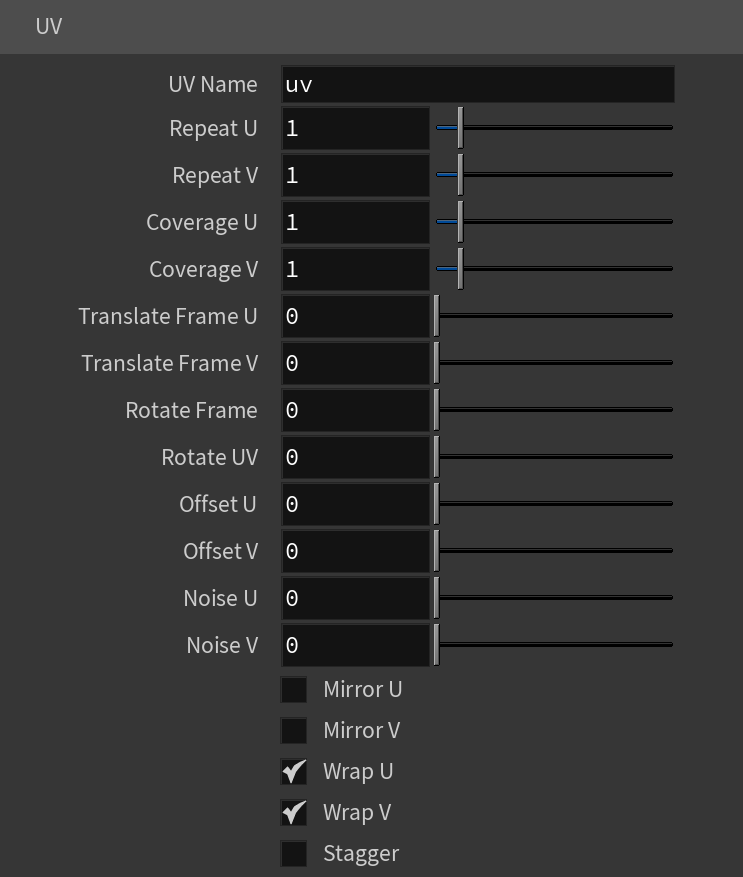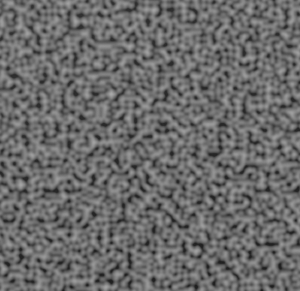This page provides information on the V-Ray Bercon Noise Texture.
Overview
V-Ray Bercon Noise is a procedural noise texture that offers a great deal of control. It allows you to change both the Noise Type and also to specify a Fractal type to use. If a texture is connected to the Distortion channel, this texture is used to distort the noise produced.
General
Mix
Color 1 – Controls the choice of color for the first color used by the texture.
Color 2 – Controls the choice of color for the second color used by the texture.
Size – Controls the size of the noise procedural produced.
Low – Controls the color of the large details. Low values are lighter, higher values are darker.
High – Controls the color of the smaller details. Low values are lighter, higher values are darker.
Distortion
Use Distortion – Enables the use of distortion. When a texture map is connected to this channel, it distorts the V-Ray Bercon Noise texture depending on the texture map.
Distortion Strength – Specifies the strength of distortion. Solid colors have no effect and the more contrast in the connected texture, the more visible the distortion.
Curve
Use Curve Input – Specifies whether the calculated blend amount to be transformed by the Bezier curve.
Noise
Function
Uvw – Controls how the procedural texture is mapped and gives a choice between Normal, Radial, and Spherical.
Noise Type – Allows the choice between noise types to use for the procedural texture. The types are Perlin 2D, Perlin 3D, Perlin 4D, Simplex 2D, Simplex 3D, Simplex 4D, and Worley (Voronoi). For more information, see the Noise Types example below.
Phase – Specifies the noise phase.
Spread – Specifies the Worley spread.
F1/F2/F3/F4 – Specifies the Worley noise.
Distance – Specifies the Worley distance. The options are Linear, Square, Manhattan, Chebychev, Minkovsky 0.5, and Minkovsky 4.
Fractal
Fractal – Allows the choice between fractals to be used by the procedural noise. The options for fractals are None (no fractal shall be used if this is selected), Fractal, Turbulence, fBm, fBm Turbulence, Hetero Terrain, Hybrid Multi Fractal, and Ridged Multi Fractal. When a choice other than None is chosen, channels allowing control of the specified fractal type appear. For more information, see the Fractal Types example below.
Levels – Specifies the fractal levels.
Offset – Specifies the fractal offset.
Gain – Specifies the fractal gain.
Lacunarity – Specifies the fractal lacunarity.
Exponent – Specifies the fractal exponent.
Output
Camera Space – Enables calculations in camera space.
Color Tweaks
Default Color – Specifies a color when there are no valid UVW coordinates.
Mult – Specifies a multiplier for the texture color.
Offset – Color corrects the texture by adding the RGB color values specified here to the RGB color values in the texture.
Invert – When enabled, the resulting texture color is inverted.
Alpha Tweaks
Source – Specifies the alpha source from Alpha, Color, and Opaque.
Use – Differentiates between textures exported from different applications. You can choose between Color Intensity (3ds Max) and Color Luminance (Maya).
Mult – Specifies a multiplier for the texture alpha.
Offset – Specifies an additional offset for the texture alpha.
Invert – When enabled, the resulting texture alpha is inverted, too. If disabled, just the color is inverted.
Placement
Placement Type – Specifies the way the valid portion of the texture is applied. The options are Full, Crop, and Place.
U/V – Specifies the U/V coordinates of the valid texture sector.
W – Specifies the width of the valid texture sector.
H – Specifies the height of the valid texture sector.
Jitter – Specifies the amount of random placement variation.
Tile U – When enabled, there is horizontal tiling.
Tile V – When enabled, there is vertical tiling.
UV Noise
Enabled – Enables the UV noise.
Amount – Specifies the UV noise amount.
Levels – Specifies the UV noise iterations.
Size – Specifies the UV noise size.
Animated – When enabled, the noise is animated.
Phase – Specifies the UV noise phase.
Type – Specifies the mapping type. UV Name – The name of the UV channel that is used. Repeat U – Multiplier for U values. Repeat V – Multiplier for V values. Coverage U – U values are remapped to 1.0. Coverage V – V values are remapped to 1.0. Translate Frame U – Translates the frame in U direction after applying rotate_frame (and before wrap, coverage, clamp). Translate Frame V – Translates the frame in V direction after applying rotate_frame (and before wrap, coverage, clamp). Rotate Frame – Rotates the frame after applying UV noise. Rotate UV – Rotates the UVs after mirroring. Offset U – Offset added to U before mirroring (after wrap, coverage, clamp). Offset V – Offset added to V before mirroring (after wrap, coverage, clamp). Noise U – Noise magnitude multiplier in U direction. Nose V – Noise magnitude multiplier in V direction. Mirror U – When enabled, every other tile outside the [0;1] range is mirrored in U. Mirror V – When enabled, every other tile outside the [0;1] range is mirrored in V. Wrap U – When enabled, U values outside the [0;1] range wrap back to [0;1]. Wrap V – When enabled, V values outside the [0;1] range wrap back to [0;1]. Stagger – When enabled, tiles in the V direction add +0.5 to the U value for a 'staggering' effect. Type – Specifies the type of projection mapping to use from the following:None Planar Projection Camera – Selects a camera. Projection Camera (LOP) – Same as Projection Camera parameter but for use in the LOP context. Fit Fill – Specifies how the projection is fitted. Vertical – Fitted vertically. Fit Type – Specifies the type of fitting to use: None U / V Angle – Specifies the U / V mapping angle. Film Gate W / H – Specifies the width / height of the film gate. Hide Backface – Determines whether to project on back faces of polygons. Hide Occluded – Determines whether to project on occluded points when using the Perspective Type. Object Space – When enabled, the projection is applied in the object space of the currently shaded geometry. Use Reference Points – Uses reference mesh/rest inputs for projection calculations. Mapping Type – Specifies the type and shape of the texture from the following: Spherical, Angular, Cubic, Mirror Ball, Screen, Spherical (3ds Max), Cylindrical (3ds Max), Shrink Wrap (3ds Max), and Spherical (V-Ray). Horizontal Flip – Flips the environment horizontally. Vertical Flip – Flips the environment vertically. Horizontal Rotation – Specifies the horizontal rotation (left and right). Vertical Rotation – Specifies the vertical rotation (up and down). Texture Rotation – Specifies the texture rotation. Wrap U – If true, U values outside the [0;1] range wrap back to [0;1]. You can choose between the No Wrapping, Wrap and Mirror Tile options. Wrap V – If true, V values outside the [0;1] range wrap back to [0;1]. You can choose between the No Wrapping, Wrap and Mirror Tile options. Wrap X – If true, X values outside the [0;1] range wrap back to [0;1]. You can choose between the No Wrapping, Wrap and Mirror Tile options. Crop U / V / W – Enables or disables cropping in the U / V / W direction. DUVW Scale – Specifies an additional scale factor for the texture derivatives. Ground – Enables ground projection of the texture. Ground Radius – When Ground is enabled, this specifies the radius of the ground. Ground Position – When Ground is enabled, this specifies the coordinates for the ground.Mapping
Spherical
Cylindrical
Ball
Cubic
Tri-Planar
Perspective
Fit Fill – Fitted to fill the space.
Horizontal – Fitted horizontally.
Match Camera Film Gate
Match Camera Resolution
Example: General
All the examples in this section use Perlin 3D as Noise Type and have Fractal set to None.
Size: 0.1 | Size: 0.25 | Size: 0.5 | Size: 0.75 | Size: 1 |
|---|---|---|---|---|
Low: 0 | Low: 0.25 |
Low: 0.5 | Low: 0.75 |
Low: 1 |
High: 0 | High: 0.25 | High: 0.5 | High: 0.75 | High: 1 |




































